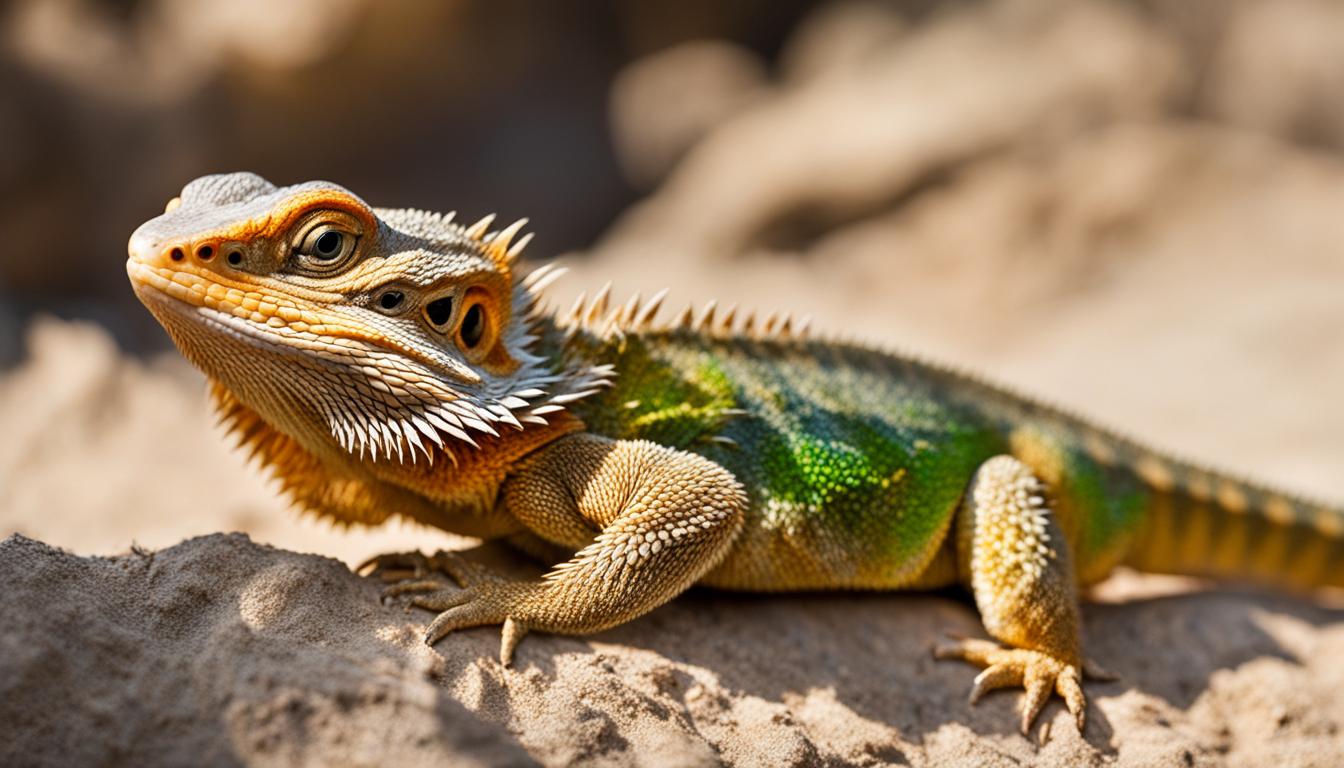Are you considering a bearded dragon as a pet and wondering how to provide the best care for these fascinating reptiles? Look no further! In this article, we will cover everything you need to know about bearded dragon care, from their habitat and diet to grooming and behavior.
Bearded dragons, also known as “beardies,” are popular pet lizards loved for their docile nature and beautiful appearance. They get their name from the scaled and spiked area below their neck, known as the “beard,” which can change colors and expand based on their mood. These amazing creatures are typically bred in captivity in the United States and come in multiple color variations, including bright yellow or orange variants.
Key Takeaways:
- Bearded dragons are docile and make excellent, easy-to-care for pets.
- They require spacious enclosures with proper temperature and lighting.
- Bearded dragons have specific dietary needs, including a combination of insects and vegetables.
- Grooming and enrichment are essential for their well-being.
- Regular veterinary check-ups and monitoring their behavior are important for their health.
Bearded Dragon Housing
Providing a suitable habitat is essential for the well-being of your bearded dragon. Here are some important factors to consider:
Enclosure Size
Bearded dragons require spacious environments to thrive. For adult dragons, a minimum of a 75-gallon terrarium is recommended. The larger the enclosure, the better. This allows your bearded dragon to have ample room to move, explore, and bask.
Ventilation and Substrates
Enclosures should have a screen top to ensure proper ventilation. This helps maintain a healthy airflow within the habitat. When it comes to substrates, it’s important to choose materials that are safe for your bearded dragon. Opt for tile, newspaper, or reptile carpet as suitable options. Avoid using substrates like sand or wood chips, as they can be ingested and cause health issues.
Temperature and UVB Lighting
Bearded dragons are ectothermic creatures, which means they rely on external sources of heat to regulate their body temperature. During the day, maintain a temperature range of 80-88 degrees Fahrenheit in the enclosure. Create a basking spot with a temperature of 95-105 degrees Fahrenheit to allow your dragon to thermoregulate.
UVB lighting is crucial for bearded dragons as it helps them process calcium and vitamin D. Consider using special bulbs or overhead self-ballasted mercury vapor lamps to provide adequate UVB light.
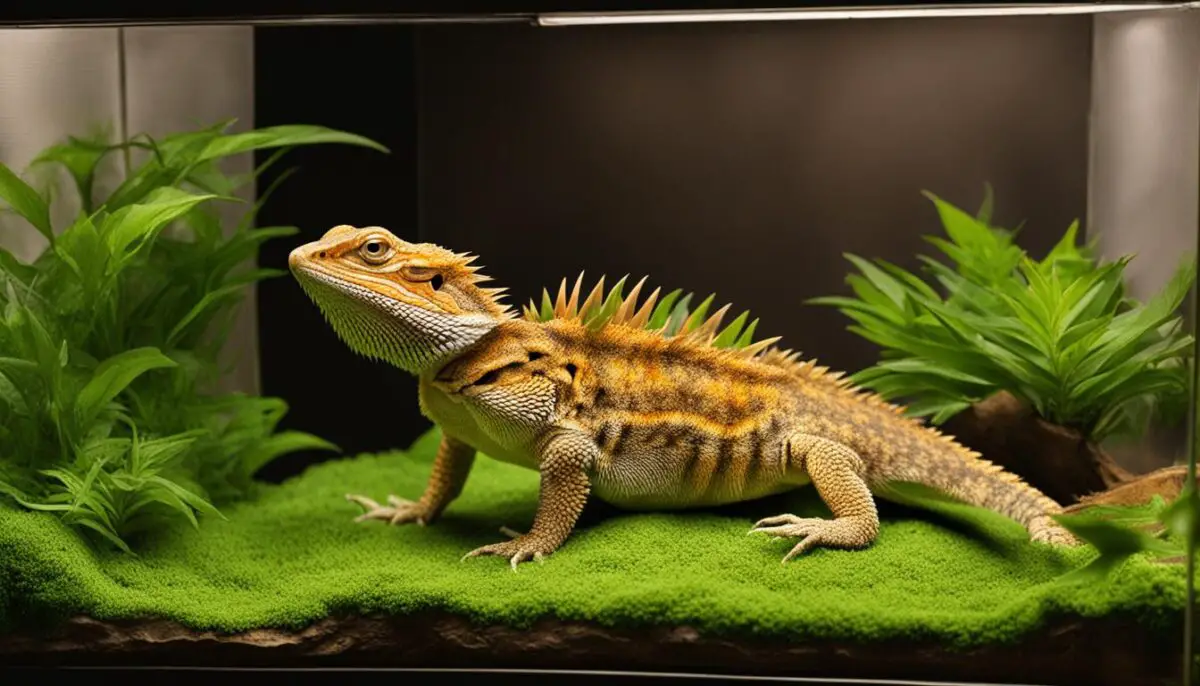
Key Points:
- Provide a spacious terrarium with a minimum size of 75 gallons for adult bearded dragons.
- Ensure proper ventilation by using a screen top for the enclosure.
- Choose appropriate substrates such as tile, newspaper, or reptile carpet.
- Maintain a temperature range of 80-88 degrees Fahrenheit during the day with a basking spot of 95-105 degrees Fahrenheit.
- Use UVB lighting to support proper calcium and vitamin D processing.
Proper housing is critical for the health and happiness of your bearded dragon. By creating a suitable habitat, you can ensure your pet thrives in a comfortable and secure environment.
Temperature and Lighting
Proper temperature and lighting are crucial for the health and well-being of bearded dragons. These reptiles require a specific temperature gradient in their enclosure, which includes a cool side where they can retreat and a basking area where they can soak up warmth.
During the day, it is important to maintain a temperature range of 80-88 degrees Fahrenheit (26-31 degrees Celsius) throughout the enclosure. The basking spot should provide a higher temperature of 95-105 degrees Fahrenheit (35-41 degrees Celsius). This temperature variation allows bearded dragons to regulate their body temperature effectively.
At night, the temperature can drop to around 70 degrees Fahrenheit (21 degrees Celsius). This drop in temperature simulates their natural environment and supports their overall well-being.
Alongside appropriate temperature, bearded dragons also rely on proper lighting to thrive. UVB lighting is essential for these reptiles as it helps them process calcium and vitamin D3, which are crucial for their bone health.
Bearded dragons can obtain UVB light through special bulbs designed specifically for reptiles or through overhead self-ballasted mercury vapor lamps. Whichever option you choose, ensure that the UVB bulbs are replaced every 6-12 months to maintain optimal output.
Remember, providing the right temperature and lighting conditions is essential for the overall health and happiness of your bearded dragon.
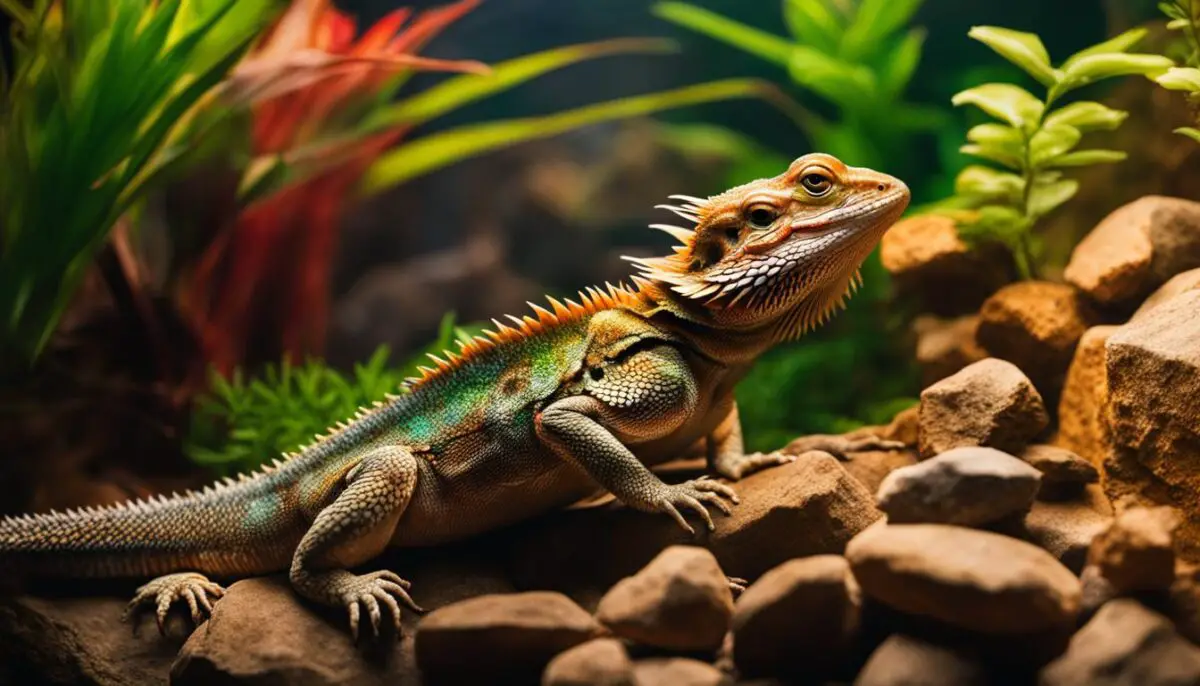
Key Points:
- Bearded dragons require a temperature gradient in their enclosure.
- Daytime temperatures should range from 80-88 degrees Fahrenheit (26-31 degrees Celsius).
- Provide a basking spot with a temperature of 95-105 degrees Fahrenheit (35-41 degrees Celsius).
- At night, the temperature can drop to around 70 degrees Fahrenheit (21 degrees Celsius).
- UVB lighting is necessary for bearded dragons to process calcium and vitamin D3.
- Choose either specialized UVB bulbs or overhead self-ballasted mercury vapor lamps.
- Replace UVB bulbs every 6-12 months for optimal performance.
Humidity and Enrichment
Proper humidity and enrichment are essential for the overall health and well-being of your bearded dragon. In this section, we will explore how to maintain the ideal humidity level and provide enrichment activities for your pet.
Humidity
Bearded dragons require a humidity level of 40-60% in their enclosure to support healthy respiratory function and shed their skin effectively. To maintain the appropriate humidity, consider the following:
- Place a shallow water bowl in the enclosure. Not only will this provide a source of drinking water for your bearded dragon, but it will also increase the humidity in the immediate area.
- Occasionally soak your bearded dragon in a shallow bath of lukewarm water. This helps them stay hydrated and promotes proper shedding.
- Create a hiding area with increased humidity. This can be achieved by using a larger moist substrate or adding a moist moss pad or reptile humidifier to a specific area of the enclosure.
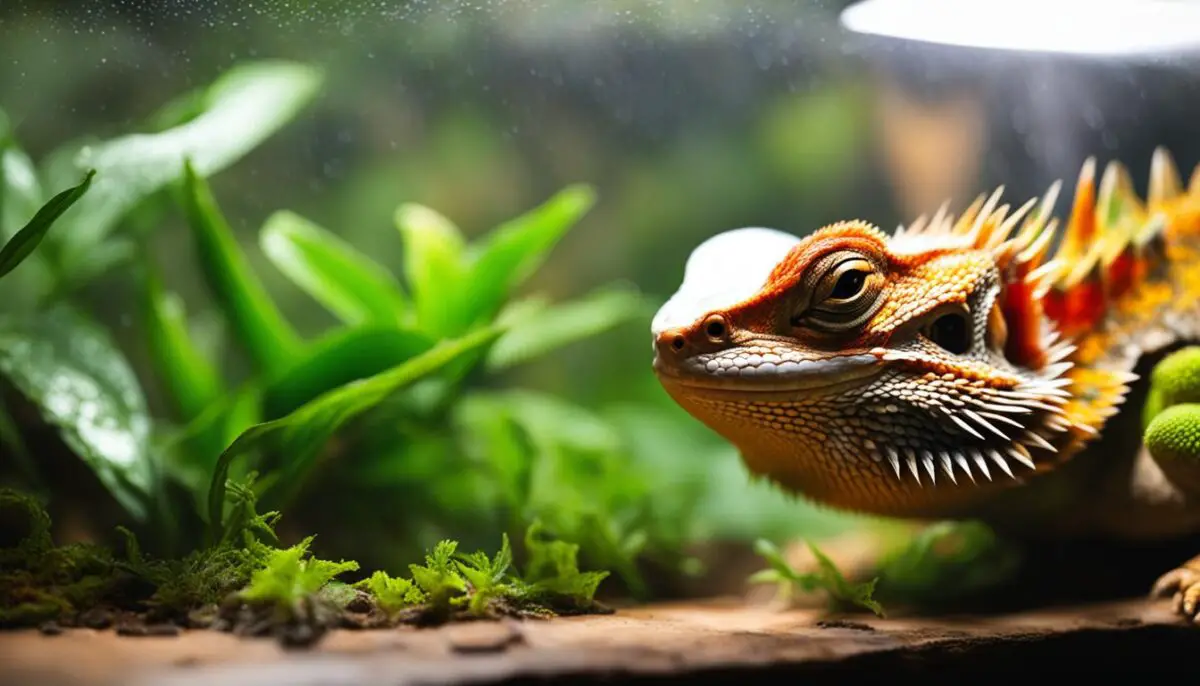
Enrichment
Enrichment activities are crucial for keeping your bearded dragon mentally stimulated and providing them with a fulfilling environment. Here are some ideas to enrich their habitat:
- Include burrows or caves in the enclosure where your bearded dragon can hide and explore. This mimics their natural behavior in the wild.
- Add climbing branches or rocks to encourage exercise and provide opportunities for your bearded dragon to climb and perch.
- Introduce treat balls filled with nutritious treats to engage your bearded dragon’s natural foraging instincts. This not only provides mental stimulation but also promotes physical activity.
Remember, bearded dragons should not be allowed unsupervised free roam of your house as it may pose a risk to their safety and well-being.
By maintaining the proper humidity level and incorporating enrichment activities, you can ensure that your bearded dragon thrives in its habitat and enjoys a fulfilling and healthy life.
| Humidity Tips: | Enrichment Ideas: |
|---|---|
| Place a shallow water bowl in the enclosure. | Include burrows or caves in the enclosure. |
| Soak your bearded dragon in a shallow bath. | Add climbing branches or rocks. |
| Create a hiding area with increased humidity. | Introduce treat balls filled with nutritious treats. |
Foods for Bearded Dragons
Proper nutrition is crucial for the health and well-being of bearded dragons. As omnivores, they require a balanced diet of insects and vegetables to thrive. Here’s a breakdown of their dietary needs:
Insects
Insects should make up approximately 25% of an adult bearded dragon’s diet. It’s important to choose a variety of nutritious insects that are appropriately-sized for your pet. Some suitable options include:
- Crickets
- Dubia roaches
- Mealworms
- Waxworms
When feeding insects, it’s essential to “gut-load” them beforehand. This means feeding the insects a nutritious diet to enhance their nutritional value for your bearded dragon. Additionally, dusting them with a calcium supplement is recommended to ensure the proper intake of essential minerals.
Vegetables
Vegetables should make up the majority of a bearded dragon’s diet, accounting for approximately 50-55%. Dark leafy greens are particularly beneficial and should be the foundation of their vegetable intake. Some suitable vegetables include:
- Kale
- Collard greens
- Mustard greens
- Turnip greens
- Butternut squash
It’s important to offer a variety of vegetables to ensure a well-rounded diet and to provide essential vitamins and minerals. Remember to thoroughly wash the vegetables before feeding them to your bearded dragon.
Fruits
Fruits should be given sparingly as treats, accounting for around 10-15% of their diet. While fruits are a source of vitamins and natural sugars, they should not be the primary component of their diet. Some suitable fruits include:
- Blueberries
- Strawberries
- Mango
- Papaya
Offer small, bite-sized pieces of fruit as an occasional treat to prevent excessive sugar intake.
Feeding Schedule
The feeding schedule for bearded dragons varies based on their age and body condition:
- Hatchlings (0-4 months): Feed 2-3 times a day, offering a variety of appropriately-sized insects and finely chopped vegetables.
- Juveniles (4-12 months): Feed once or twice a day, gradually increasing the size of insects and providing a wider assortment of vegetables.
- Adults (12 months and older): Feed every 24-48 hours, adjusting the quantity based on their size and activity level. Provide a balanced mix of insects and vegetables.
Always ensure that fresh water is available for your bearded dragon, although they typically obtain most of their hydration from the food they consume.
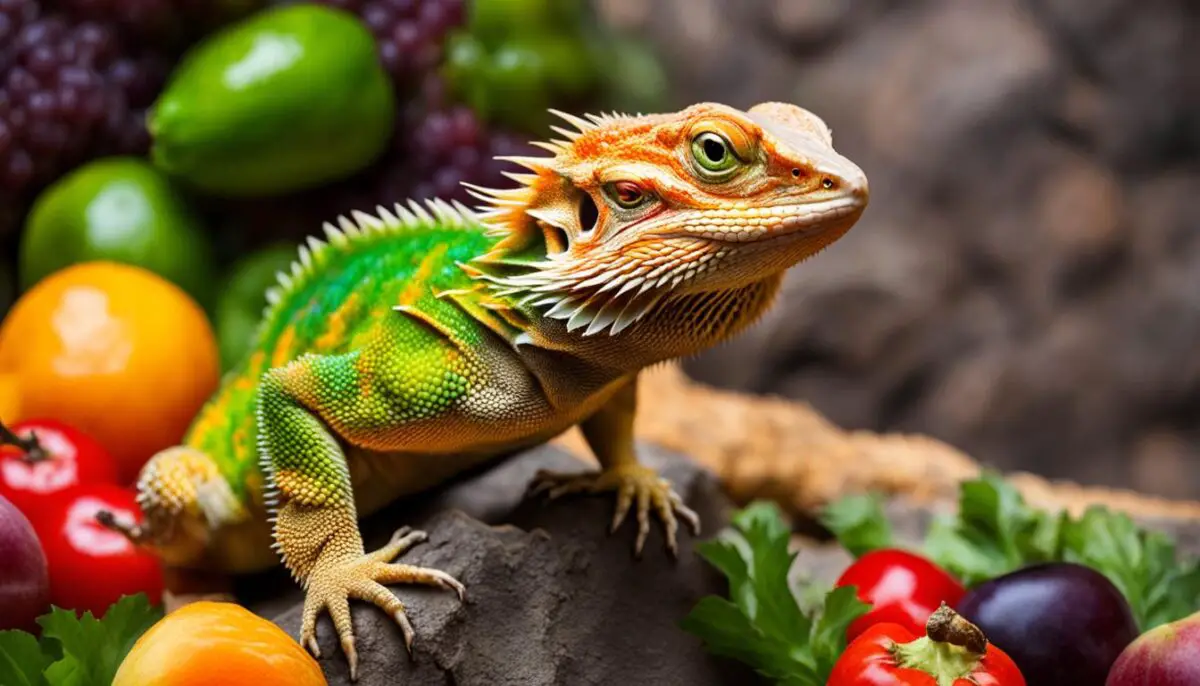
Nutritional Value of Common Insects
| Insect | Protein Content | Calcium Content | Phosphorus Content |
|---|---|---|---|
| Crickets | 19.1g per 100g | 58mg per 100g | 313mg per 100g |
| Dubia Roaches | 18g per 100g | 205mg per 100g | 400mg per 100g |
| Mealworms | 20g per 100g | 52mg per 100g | 368mg per 100g |
| Waxworms | 15.5g per 100g | 8mg per 100g | 196mg per 100g |
Source: Nutritional information sourced from reputable insect breeders and scientific studies.
Insect Calcium and Multivitamin Dusting
Proper supplementation is crucial for maintaining the health of your bearded dragon. In addition to their regular diet, bearded dragons require additional calcium, vitamins, minerals, and trace elements to support their overall well-being.
Calcium with vitamin D3 should be dusted on the food of adult bearded dragons 2-3 times a week. This ensures that they receive adequate amounts of calcium, which is essential for bone health and proper muscle function. Juvenile bearded dragons, on the other hand, have higher calcium requirements due to their rapid growth. Therefore, it is recommended to dust their food with calcium 4-5 times a week.
In addition to calcium, a reptile multivitamin should be dusted on the food of juvenile bearded dragons once a week and adult bearded dragons twice a month. This multivitamin supplementation provides the necessary vitamins, minerals, and trace elements that may be lacking in their regular diet.
By incorporating regular supplementation into your bearded dragon’s care routine, you can ensure that they receive the essential nutrients they need for optimal health and development.
Supplementation Schedule:
| Age | Calcium with Vitamin D3 | Multivitamin |
|---|---|---|
| Adult | 2-3 times a week | Twice a month |
| Juvenile | 4-5 times a week | Once a week |
Quotes:
The proper supplementation of calcium and multivitamins is crucial for the ongoing health and well-being of bearded dragons. This ensures they receive the necessary nutrients for strong bones, muscle function, and overall vitality.
Key Takeaways:
- Calcium with vitamin D3 should be dusted on the food of adult bearded dragons 2-3 times a week, while juvenile bearded dragons require calcium dusting 4-5 times a week.
- A reptile multivitamin should be dusted on the food of juvenile bearded dragons once a week and adult bearded dragons twice a month.
- Supplementation provides essential nutrients to support bone health, muscle function, and overall development.
Conclusion
Bearded dragons are fascinating pets that require specific care to ensure their health and well-being. Proper housing, temperature, lighting, humidity, and a balanced diet are essential for their care.
When it comes to housing, providing a spacious enclosure with the right substrate and ventilation is crucial. Maintaining the correct temperature gradient and providing UVB lighting are also necessary for their overall health.
Additionally, bearded dragons need a proper humidity level and enrichment to keep them mentally stimulated. Feeding them a balanced diet of insects and vegetables, along with proper calcium and vitamin supplementation, is vital for their nutrition.
Regular veterinary check-ups and monitoring for any signs of illness are essential to catch any health issues early on. By giving your bearded dragon the right care and attention, you can enjoy their companionship and entertainment for many years to come.
FAQ
Are bearded dragons good pets?
Yes, bearded dragons make excellent, easy-to-care for pets with a lifespan of 8-10 years. They are docile and rarely bite.
Why are they called bearded dragons?
Bearded dragons get their name from the scaled and spiked area below their neck, known as the “beard,” which can change colors and expand based on mood.
Where are bearded dragons typically bred?
Bearded dragons are typically bred in captivity in the United States.
What colors do bearded dragons come in?
Bearded dragons come in multiple color types, including bright yellow or orange variants.
What size enclosure do bearded dragons need?
Bigger enclosures are better for bearded dragons, with a minimum size of a 75-gallon terrarium for adults.
What kind of substrates should I use in the enclosure?
Acceptable substrates for bearded dragons include tile, newspaper, or reptile carpet. Sand or wood chips should be avoided as they can be ingested.
What temperature should I maintain in the enclosure?
The temperature should be maintained between 80-88 degrees Fahrenheit during the day, with a basking spot of 95-105 degrees.
Why is UVB lighting important for bearded dragons?
UVB lighting is essential for bearded dragons to process calcium and vitamin D.
How should I maintain the humidity in the enclosure?
Bearded dragons require a humidity level of 40-60%, which can be maintained through a shallow water bowl and occasional soaking or increased humidity in a hiding area.
What kind of enrichment is important for bearded dragons?
Enrichment for bearded dragons should include burrows, climbing branches or rocks, and treat balls for mental stimulation. They should not be allowed unsupervised free roam of the house.
What should be the diet of a bearded dragon?
Bearded dragons are omnivores and require a diet of insects and vegetables. Insects should make up 25% of the adult’s diet and vegetables should comprise 50-55%.
How often should I feed my bearded dragon?
Bearded dragons should be fed based on their age and body condition, with hatchlings eating 2-3 times a day and adults eating every 24-48 hours.
What supplements do bearded dragons need?
Bearded dragons require additional calcium, vitamins, minerals, and trace elements. Calcium with vitamin D3 should be dusted on adults’ food 2-3 times a week, and juveniles’ food 4-5 times a week.

